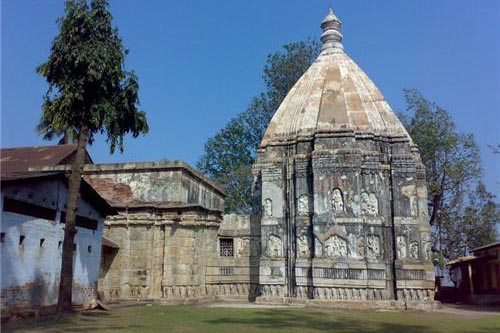Hayagriva Madhava Temple

Information of Hayagriva Madhava Temple, Hajo, Kamrup, Assam
The Hayagriva Madhava Temple is located on the top of the Monikut mountain. The mountain or the hill is located in Hajo which lies on the western side of Guwahati in the state of Assam. Hajo is considered to be quite an imperative pilgrimage hub in Assam for Buddhism, Islam and Hinduism. The ancient harmonious convergence of the mentioned form of religious practices can still be observed in this place till date.
Hayagriva Madhava Temple Religious Significance
The Hayagriva Madhava Temple is acknowledged to be quite an ancient shrine of the state and is dedicated to Lord Vishnu. The temple is held in high reverence both by the Hindus and the Buddhists. The representation of Lord Vishnu's image in this temple bears a stark similarity with the figure of Lord Jagannath at Puri Temple in Orissa. The shrine is also regarded as one of the main places of worship by the Bhutiyas and the Lamas as both of them follow Buddhism. It is strongly believed by them that this is the place where Lord Buddha attained Moksha or Nirvana and the figure positioned inside the shrine is actually a representation of their Lord that is Buddha. Hayagriva refers to a particular form of Vishnu where the Lord has the head of a horse.
Hayagriva Madhava Temple Mythology & History
A number of mythological references are known to be associated with the aspect of embodiment of the Hayagriva Madhava. According to the local legends, the Avatara or the story of incarnation is related to the popular Hindu epic, Mahabharata. It has been stated in the epic that while Lord Vishnu was asleep and Lord Brahma was seated on a lotus, two evil spirits or demons called Kaitabha and Madhu stole the Vedas from Lord Brahma and left for Rasatala. As a result of the act, Lord Brahma became upset and appealed for the repossession of the stolen Vedas to Lord Vishnu by waking him up from his sleep. Vishnu appeared as Hayagriva and successfully returned the Vedas to Lord Brahma after recovering them from the demons. Lord Vishnu again went back to sleep in the same appearance of Hayagriva towards the northeast and was confronted here by the mentioned demons. The confrontation led to a war in which both the demons were slayed by Vishnu.
Hayagriva Madhava Temple Architectural Significance
The existing structure of the temple was established by a King named Raghudeva Narayan in the year 1583. According to the researches of a few historians it is said that the temple was built by the King from the Pala dynasty during the 6th century. The temple is basically made of stone and carvings of lines of elephants can be still observed on the walls of the temple which are considered to be excellent samples of Assamese form of art. A huge pond is located close to the temple which is known as the Madhab Pukhuri. The temple is quite well known for its universal pattern of architecture. The main area of the temple is reached through a series of steps made of stone slabs. The temple is octagonal in shape and has a diameter of about 30 feet and includes a pyramidal form of roof. The temple includes three different parts or portions and they are the centre, the basement and the Sikhara which extends till a peak point. The complete structure is founded on huge pillars made of bricks and is believed to be an addition made later to the actual temple structure which was probably built by King Naranarayan of Kochi during the 15th era.
- Andhra Pradesh Temples
- Assam Temples
- Bihar Temples
- New Delhi Temples
- Goa Temples
- Gujarat Temples
- Jammu and Kashmir Temples
- Karnataka Temples
- Kerala Temples
- Madhya Pradesh Temples
- Maharashtra Temples
- Odisha Temples
- Punjab Temples
- Rajasthan Temples
- Sikkim Temples
- Tamil Nadu Temples
- Telangana Temples
- Uttar Pradesh Temples
- Uttarakhand Temples
- West Bengal Temples